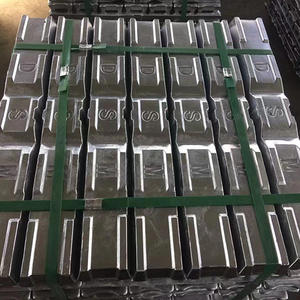Ingot casting is a manufacturing process used to produce metal ingots, which are large blocks or bars of metal typically used as raw material for further processing in various industries. The ingot casting process involves the solidification of molten metal into a mold or container to form a solid block or shape.

Here is a step-by-step overview of the ingot casting process:
1. Furnace Melting: The first step in ingot casting is the melting of the metal. The metal is heated in a high-temperature furnace until it reaches its melting point and becomes a molten liquid.
2. Mold Preparation: The molds used in ingot casting are typically made of steel or cast iron and are designed to withstand the high temperatures and pressures of the process. The molds are preheated to prevent rapid cooling of the molten metal.
3. Mold Coating: Before pouring the molten metal, the molds may be coated with a refractory material or a special coating to facilitate the release of the solidified ingot and prevent sticking or surface defects.
4. Pouring: The molten metal is carefully poured into the prepared molds. The pouring process needs to be controlled to prevent turbulence or excessive splashing, which could lead to defects in the ingot.
5. Solidification: As the molten metal cools and solidifies within the mold, it takes on the shape of the mold cavity. The cooling rate and solidification process may be controlled to optimize the structure and properties of the resulting ingot.
6. Removal from the Mold: Once the metal has solidified and cooled sufficiently, the mold is opened, and the solidified ingot is removed. Depending on the size and weight of the ingot, lifting equipment or machinery may be used for extraction.
7. Inspection and Processing: The cast ingots are inspected for surface defects, dimensional accuracy, and overall quality. They may undergo further processing, such as cutting, grinding, or heat treatment, to meet specific requirements before they are used in downstream applications.

Ingot casting is a widely used method for producing metal ingots, which serve as important raw materials in industries such as metallurgy, foundries, and manufacturing. The process allows for the efficient production of large quantities of metal blocks with consistent quality and dimensions, enabling subsequent processing and utilization in various applications. When casting ingots, precise casting can be achieved through the Ingot Casting Machine, which not only ensures the integrity of the process, but also allows the ingots to achieve better casting effects.
 English
English  Español
Español  Português
Português  русский
русский  français
français  日本語
日本語  Deutsch
Deutsch  Tiếng Việt
Tiếng Việt  Italiano
Italiano  Nederlands
Nederlands  ไทย
ไทย  Polski
Polski  한국어
한국어  Svenska
Svenska  Malay
Malay  বাংলা
বাংলা  हिन्दी
हिन्दी  Pilipino
Pilipino  Türk
Türk  عربى
عربى  Indonesia
Indonesia  norsk
norsk  čeština
čeština  Українська
Українська  Javanese
Javanese  فارسی
فارسی  తెలుగు
తెలుగు  Burmese
Burmese  български
български  Latine
Latine  Azərbaycan
Azərbaycan  Српски
Српски  Esperanto
Esperanto  Afrikaans
Afrikaans  Català
Català  Cymraeg
Cymraeg  Беларус
Беларус  Hrvatski
Hrvatski  Kreyòl ayisyen
Kreyòl ayisyen  Shqiptar
Shqiptar  Bosanski
Bosanski  Кыргыз тили
Кыргыз тили  ಕನ್ನಡ
ಕನ್ನಡ  IsiXhosa
IsiXhosa  Chichewa
Chichewa  Somali
Somali  O'zbek
O'zbek  հայերեն
հայերեն  Sundanese
Sundanese  Malagasy
Malagasy 







